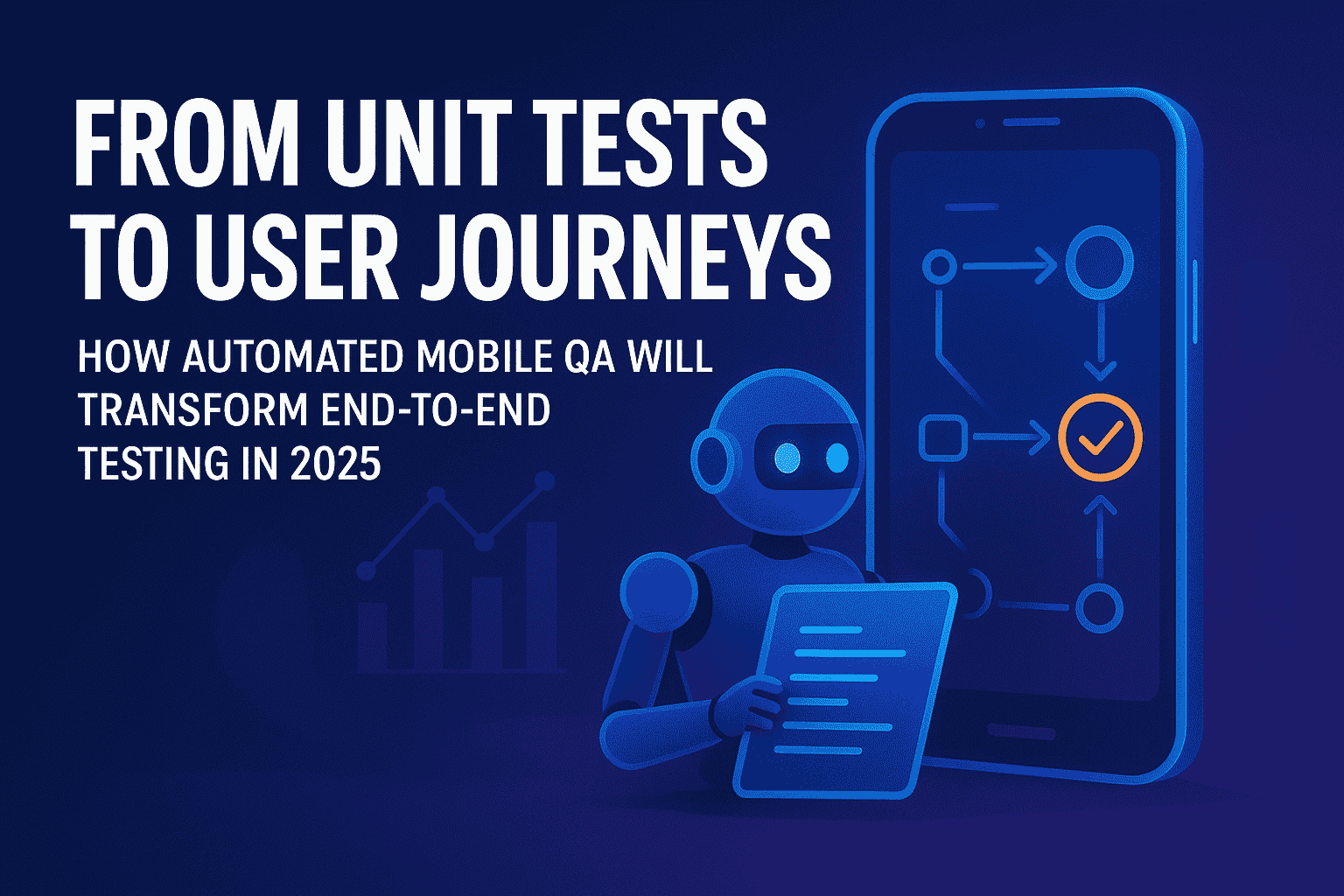The mobile QA landscape is at a turning point. Developers have long relied on a pyramid testing approach—unit tests at the base, integration tests in the middle, and end-to-end (E2E) tests at the top. But this segmented strategy is failing to keep up with the complexity of modern mobile apps. AI-driven development is radically reshaping how teams validate mobile experiences, bridging the gap between granular tests and full user journeys.
The Limitations of Traditional Testing
Unit testing verifies individual components quickly and is useful for catching early bugs. However, it cannot detect issues arising when components interact or workflows span multiple systems. End-to-end testing addresses these gaps but is expensive, slow, and fragile.
Teams face a tough choice between fast, narrow-scope unit tests and comprehensive but brittle E2E tests. Many bugs are still caught only after release, causing costly user-impacting failures. Mobile apps complicate matters further due to device fragmentation and frequent OS updates. Maintaining manual or brittle automated tests across thousands of devices is a near-impossible task.
The challenge is especially acute given the myriad devices and OS versions mobile apps must support. Android alone has over 24,000 device variants with unique screen sizes, hardware constraints, and capabilities. iOS updates introduce UI and performance changes as well. This device and OS fragmentation makes it nearly impossible for manual or traditional automation teams to comprehensively verify user experiences before release.
Automated Mobile QA; The Game Changer
AI-powered testing platforms break this stalemate by delivering self-healing tests, predictive defect detection, and autonomous test generation. These advances enable faster, more reliable validation of mobile apps across real devices and diverse scenarios.
Self-healing tests adapt automatically to UI changes without manual intervention, cutting test maintenance time by over 60%. This is vital for mobile apps with frequent UI updates across device types and OS versions.
Predictive analytics use reinforcement learning to analyze code changes and past test results, flagging high-risk areas before bugs manifest. This shifts QA from a reactive process to a proactive quality driver.
Autonomous test generation leverages natural language processing and intelligent analysis to create robust tests from user stories and specifications. This dramatically reduces the time and expertise needed to build comprehensive test suites.
AI also enables visual and performance regression detection by automatically comparing app screenshots and behavior against baseline standards, quickly identifying UI anomalies, rendering issues, and performance degradations that humans might miss.
Impactful Metrics and Trends
AI is transforming mobile QA in measurable ways. Here are vital statistics demonstrating this impact:
| Metric | Current Status | Impact |
|---|---|---|
| AI Tool Adoption | 72% of QA teams use AI in testing | Rapid industry shift toward AI |
| Positive AI ROI | 36% report positive ROI; 21% significant | ROI in 6-12 months |
| Automation Replacing Manual | 46% replaced over half manual testing | QA cycle time cut by 30-40% |
| Test Maintenance Reduced | Up to 70% reduction with self-healing AI | Frees QA for strategic activities |
| Debugging Time Saved | AI saves 3-4 hours daily per developer | Accelerates release cycles |
| Market Growth | $426M in 2023 to $2B+ expected by 2033 | Enterprise AI adoption inevitability |
| AI/ML Investment Priority | 67% of QA leaders prioritize AI investments | Competitive advantage |
The underlying driver behind these numbers is the complex reality for mobile apps today: users demand flawless experiences, but testing teams struggle to keep pace. AI driven techniques like vibe debugging helps bridge this gap.
Evolution from Unit Testing to Holistic User Journeys
The AI-driven QA evolution unfolds in phases:
Intelligent Test Creation
AI analyzes codebases, APIs, user stories, and historical defects to generate detailed tests that span the spectrum—from isolated units to entire user flows. This replaces slow manual scripting with near-instant, adaptive test cases.
Natural language processing allows teams to input plain-language requirements and receive automated test scenarios that evolve as features shift. This rapid test generation keeps pace with agile and CI/CD environments.
Real Devices and Cloud Labs
AI-based test orchestration selects and runs tests in parallel across thousands of cloud-hosted real devices. Unlike simulators or in-house labs, this approach guarantees coverage on authentic hardware and OS combinations.
The platform prioritizes device/test combinations with the highest business impact based on user analytics, ensuring critical paths are always verified.
Visual and Performance Regression Detection
Automated visual comparison detects UI glitches, layout shifts, and color rendering issues across devices. AI-driven mobile QA monitor app responsiveness and resource usage, flagging unexpected slowdowns or battery drains before release.
Continuous Learning and Adaptation
AI platforms continually learn from test failures, production incidents, and usage patterns, refining test coverage, key testing metrics, and defect predictions. This forms a self-improving quality ecosystem, reducing false positives and improving reliability.
Common Challenges AI Addresses in Traditional Mobile QA
Many challenges previously slowed down mobile QA teams:
- Maintenance Overhead: Frequent UI changes break manual and brittle automated tests. Automated Mobile QA’s self-healing reduces constant fixes.
- Device Fragmentation: Managing thousands of devices is impractical; AI cloud labs optimize coverage effectively.
- Long Feedback Loops: Old-school tests slow releases. Automated Mobile QA speeds up testing and debugging cycles.
- Lack of Context: Traditional tests miss user workflow context. Automated Mobile QA correlates code, tests, and user behavior for holistic insights.
- High Failure Rates: Bugs slip through unit tests unnoticed. AI predictive analytics reduce escapes drastically.
Panto AI: End-to-End Vibe Debugging for AutomatedMobile QA
Panto AI is redefining mobile QA by delivering an integrated end-to-end debugging experience. Unlike fragmented, disconnected tools, Panto AI unites AI code review, test automation, and production incident analysis on one intelligent platform.
Its AI engine maps code commits to test failures and production incidents, giving QA teams context-aware suggestions, from firefighting individual bugs to proactively improving app quality.
Panto AI’s “vibe” debugging approach uses deep AI insights embedded within workflows, enabling faster defect resolution and higher confidence in releases. It supports continuous testing, seamless collaboration between developers and testers, and smarter prioritization of high-impact fixes.
By connecting unit-level details to full user experience validation, Panto AI embodies the future of mobile QA: intelligent, unified, and end-to-end.
The Critical Importance of Automated Mobile QA
User expectations for mobile apps have never been higher. Research shows 71% of users abandon apps within 90 days due to bugs, crashes, or poor user experience.
This unforgiving reality means mobile teams must deliver near-perfect quality at speed. Traditional testing approaches cannot scale or adapt quickly enough.
Automated mobile QA compresses testing cycles, increases coverage, and enables early bug detection, directly translating into better product experiences and higher user retention.
Teams that invest in architecting scalable, AI-driven testing pipelines gain lasting competitive advantages: faster releases, fewer production defects, and less manual QA overhead.
Practical Steps for Teams Embracing Automated Mobile QA
To succeed in this new era, mobile QA teams should consider the following:
- Assess Current Maturity: Understand your existing test coverage, defect rates, and bottlenecks.
- Adopt AI-Enabled Platforms: Choose solutions offering autonomous test generation, self-healing, and device cloud integration.
- Integrate AI into Workflows: Align AI testing outputs with CI/CD pipelines, defect tracking, and development sprints.
- Leverage Analytics: Use AI insights to prioritize risk areas and continuously improve test relevance.
- Focus on User Journeys: Expand tests beyond components to cover real-world usage and integrations.
- Collaborate Cross-Functionally: Developers, QA, and product teams should share AI-driven quality metrics and feedback loops.
Looking Ahead: AI Will Define Mobile QA Success
The shift from unit tests to user journeys powered by AI is already underway. Early adopters report significant ROI, reduced time to market, and better app and code quality.
As AI models and tooling mature, expect mobile QA to become increasingly predictive, autonomous, and fully integrated into development lifecycles.
Ultimately, AI transforms QA from a gatekeeper role into a strategic enabler of innovation and customer delight.






